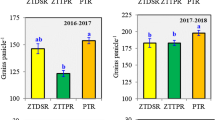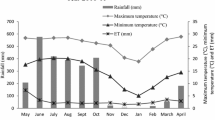Abstract
Rice fallow, a rainfed lowland agro-ecology, is presently gaining particular attention for sustainable cropping intensification in the South Asia. Nevertheless, cropping intensification of rice-fallow areas is largely challenged by non-availability of irrigation, the poor financial status of farmers and soil constraints. Indeed, fast depletion of the soil residual moisture remains the primary obstacle for growing a crop in succession in rice fallows. A field investigation was carried out to identify the most adaptable rice-winter crop rotation and to customize appropriate crop establishment practice for a winter crop that could conserve the soil moisture. Treatments comprised of three crop establishment practices for winter crops [utera (relay cropping, i.e. broadcasting of seeds in standing rice crop 15 days before harvesting), zero tillage (ZT) and ZT with mulching (ZTM)], and five post-rainy-season crops (lentil, chickpea, lathyrus, mustard and linseed). Results showed that lathyrus and lentil could be the potential winter crop in the rice-fallow condition of Eastern India. Except for mustard crop, the productivity of all the winter crops was higher in utera cropping, which was primarily attributed to early crop growth and higher soil moisture content over ZT and ZTM treatments. The higher water use efficiency was recorded under utera cropping over ZT and ZTM treatments. Higher system productivity (system rice equivalent yield) in rice–utera lathyrus (9.3 t ha−1) and rice–utera lentil (8.1 t ha−1) led to higher net returns and production efficiency over other treatments (winter crop × crop establishment practice). Benefits of rice residue mulching were prominent in lentil, mustard and linseed crop productivity. Energy use efficiency of different crop establishment practices follows the trend of utera > ZT > ZTM (p < 0.05), being highest in rice–utera lathyrus (5.3) followed by rice–utera lentil (4.8) crop rotations. The simulated data shows that winter crops grown under utera led to less emission of greenhouse gas (GHG) and low global warming potential (GWP) as compared to ZT and ZTM treatments. Rice–lathyrus, rice–lentil and rice–chickpea systems had lower N2O emission than rice–mustard and rice–linseed rotations. Hence, lathyrus and lentil could be included in rice fallows ideally with utera for sustainable cropping intensification and improving the farmers’ income in Eastern India.








Similar content being viewed by others
References
Adviento-Borbe MAA, Haddix ML, Binder DL, Walters DT, Dobermann A (2007) Soil greenhouse gas fluxes and global warming potential in four high yielding maize systems. Glob Chang Biol 13:1972–1988
Ali M, Ghosh PK, Hazra KK (2014) Resource conservation technologies in rice fallow. In: Ghosh et al (eds) Resource conservation technology in pulses. Scientific, Jodhpur, pp 83–89
Bandyopadhyay PK, Halder S, Mondal K, Singh KC, Nandi R, Ghosh PK (2018) Response of lentil (Lens culinaries) to post-rice residual soil moisture under contrasting tillage practices. Agric Res. https://doi.org/10.1007/s40003-018-0337-3
Bandyopadhyay PK, Singh KC, Mondal K, Nath R, Ghosh PK, Kumar N, Basu PS, Singh SS (2016) Effects of stubble length of rice in mitigating soil moisture stress and on yield of lentil (Lens culinaris Medik) in rice-lentil relay crop. Agric Water Manag 173:91–102
Bourai VA, Joshi PK, Birthal PS (2002) Socio-economic constraints and opportunities in rainfed rabi cropping in rice-fallow areas of India. International Crops Research Institute for the Semi-Arid Tropics, Hyderabad, India
Bouyoucos GJ (1962) Hydrometer method improved for making particle size analysis of soils. Agron J 54:464–465
Ghosh PK, Hazra KK, Nath CP, Das A, Acharya CL (2016) Scope, constraints and challenges of intensifying rice (Oryza sativa) fallows through pulses. Indian J Agron 61 (4th IAC Special Issue):S122–S128
Hanway JJ, Heidel H (1952) Soil analysis methods as used in Iowa State College, Soil Testing Laboratory, Iowa Agri, pp 541–531
Hazra KK, Venkatesh MS, Ghosh PK, Ganeshamurthy AN, Kumar N, Nadarajan N, Singh AB (2014) Long-term effect of pulse crops inclusion on soil-plant nutrient dynamics in puddled rice (Oryza sativa L.)-wheat (Triticum aestivum L.) cropping system on an Inceptisol of Indo-Gangetic Plain zone of India. Nutr Cycl Agroecosyst 100(1):95–110
IPCC (2013) Climate change 2013 the physical science basis. In: Stocker TF, Qin D, Plattner GK, Tignor M, Allen SK, Boschung J, Nauels A, Xia Y, Bex V, Midglev PM (eds) Contribution of Working Group I to the Fifth Assessment Report of the Intergovernmental Panel on Climate Change. Cambridge University Press, Cambridge and New York, pp 710–716
Jackson ML (1973) Soil Chemical Analysis. Prentice Hall of India Pvt. Ltd., New Delhi, 498
Kar G, Verma HN (2005) Phenology based irrigation scheduling and determination of crop coefficient of winter maize in rice fallow of Eastern India. Agric Water Manag 75(3):169–183
Kumar N, Hazra KK, Nadarajan N, Singh S (2016) Constraints and prospects of growing pulses in rice fallows of India. Indian Farm 66(6):13–16
Kumar R (2015) Effects of NPKS on growth, yield and quality of late sown toria varieties (Brassica rapa L. var. toria) under rainfed condition of North East India. Bangladesh J Bot 44:521–528
Kumar R, Kumar M (2015) Effect of fertility levels and seed rates on productivity, profitability and energetics of linseed (Linum usitatissimum L.) under the foot hill condition of Nagaland. Int J Agric Stat Sci 11:275–280
Kumar R, Mishra JS, Kumar R (2018a) Enhancing the productivity of rice fallows area of Eastern India through inclusion of pulses. Indian Farm 68(08):7–10
Kumar R, Mishra JS, Rao KK, Kumar R, Singh SK, Bhatt BP (2018b) Evaluation of crop establishment techniques in rice-fallows of Eastern Indo-Gangetic Plains. National Conference on Organic Waste management for Food and Environmental Security under the theme Crop Residue Management during Feb. 8–10, 2018, held at ICAR-IISS Bhopal, Madhya Pradesh, India.
Kumar R, Mishra JS, Upadhyay PK, Hans H (2019) Rice fallows in the Eastern India: problems and prospects. Indian J Agric Sci 89:567–577
Kumar S, Kumar R, Mishra JS, Dwivedi SK, Prakash V, Rao KK, Singh SK, Bhatt BP, Singh SS, Haris AA, Kumar V, Srivastava AK, Singh S, Yadav A (2018c) Productivity and profitability of rice genotypes as influenced by crop management practices under middle Indo-Gangetic Plains. Indian J Agron 63:108–112
Layek J, Chowdhury S, Ramkrushna GI, Das A (2014) Evaluation of different lentil cultivars in low land rice-fallow under no till system for enhancing cropping intensity and productivity. Indian J Hill Farm 27:4–9
Mishra JS, Kumar R, Bhatt BP (2018) Low-cost technologies for management of rice fallows in Eastern India. XXI Biennial National Symposium of Indian Society of Agronomy, 24–26 October, 2018 at MAPUAT. Udaipur, Rajasthan, India, pp 7–9
Mishra JS, Kumar R, Kumar R, Rao KK, Singh SK, Idris M, Jha BK, Naik SK, Mali, SS, Bhatt BP (2016) Evaluation of pulses and oilseed under different crop establishment methods in rice-fallows of Eastern India. Paper ID No. IAC-2016/Sym-.XII/107. 4th International Agronomy Congress on “Agronomy for Sustainable Management of Natural Resources, Environment, Energy and Livelihood Security to Achieve Zero Hunger Challenge” held during Nov. 22–26, 2016, at New Delhi, India.
NAAS (2013) Improving productivity of rice fallows. Policy Paper No. 64. National Academy of Agricultural Sciences, New Delhi, p 16
Olsen SR, Cole CW, Watanabe FS, Dean LA (1954) Estimation of available phosphorus in soils by extraction with sodium bicarbonate. USDA, Circular 939
Piper CS (1950) Soil and plant analysis. University Adelaide, Australia, p 368
Pishgar-Komleh SH, Ghahderijani M, Sefeedpari P (2012) Energy consumption and CO2 emissions analysis of potato production based on different farm size levels in Iran. J Clean Prod 33:183–191
Pratibha G, Srinivas I, Rao KV, Raju BMK, Thyagaraj CR, Korwar GR, Venkateswarlu B, Shanker AK, Choudhary DK, Srinivasrao K, Srinivasarao C (2015) Impact of conservation agriculture practices on energy use efficiency and global warming potential in rainfed pigeonpea-castor systems. Eur J Agron 66:30–40
Sarkar S, Singh SR (2007) Interactive effect of tillage depth and mulch on soil temperature, productivity and water use pattern of rainfed barley (Hordium vulgare L.). Soil Tillage Res 92:79–86
Singh RN, Praharaj CS, Kumar R, Singh SS, Kumar N, Singh U (2017) Influence of rice (Oryza sativa) habit groups and moisture conservation practices on soil physical and microbial properties in rice+lathyrus relay cropping system under rice fallows in Eastern Plateau of India. Indian J Agric Sci 87:1633–1639
Subbiah BV, Asija GL (1956) A rapid method for the estimation of nitrogen in soil. Curr Sci 26:259–260
Tubiello FN, Condor-Golec RD, Salvatore M, Piersante A, Federici S, Ferrara A, Rossi S, Flammini A, Cardenas P, Biancalani R, Jacobs H (2015) Estimating greenhouse gas emissions in agriculture: a manual to address data requirements for developing countries. Food and Agriculture Organization of the United Nations, Rome. www.fao.org/ publications
Tuti MD, Prakash V, Pandey BM, Bhattacharya R, Mahanta D, Bisht JK, Mina MK, Mina BL, Kumar N, Bhatt JC, Srivastva AK (2012) Energy budgeting of Colocasia-based cropping systems in the Indian sub-Himalayas. Energy 45:986–993
Venkatesh MS, Hazra KK, Ghosh PK, Khuswah BL, Ganeshamurthy AN, Ali M, Singh J, Mathur RS (2017) Long-term effect of crop rotation and nutrient management on soil-plant nutrient cycling and nutrient budgeting in Indo-Gangetic plains of India. Arch Agron Soil Sci 63(14):2007–2022
Walkley A, Black IA (1934) An examination of the Degtijariff method for determining soil organic matter and a proposed modification of the chromic acid titration method. Soil Sci 37:29–38
West TO, Marland GA (2002) Synthesis of carbon sequestration, carbon emissions, and net carbon flux in agriculture: comparing tillage practices in the United States. Agric Ecosyst Environ 91:217–232
Yadav GS, Lal R, Meena RS, Datta M, Babu S, Das A, Layek J, Saha P (2017) Energy budgeting for designing sustainable and environmentally clean/safer cropping systems for rainfed rice fallow lands in India. J Clean Prod 158:29–37
Funding
This research study was conducted with the financial support from the Consortia on Research Platform on Conservation Agriculture (CRP on CA), ICAR-Indian Society of Soil Science, Bhopal.
Author information
Authors and Affiliations
Corresponding author
Additional information
Responsible editor: Philippe Garrigues
Publisher’s note
Springer Nature remains neutral with regard to jurisdictional claims in published maps and institutional affiliations.
Rights and permissions
About this article
Cite this article
Kumar, R., Mishra, J.S., Rao, K.K. et al. Sustainable intensification of rice fallows of Eastern India with suitable winter crop and appropriate crop establishment technique. Environ Sci Pollut Res 26, 29409–29423 (2019). https://doi.org/10.1007/s11356-019-06063-4
Received:
Accepted:
Published:
Issue Date:
DOI: https://doi.org/10.1007/s11356-019-06063-4




